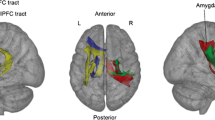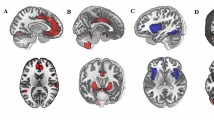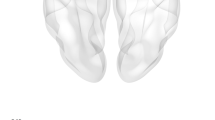Abstract
The resting state brain networks, particularly the Default Mode Network (DMN), have been found to be altered in several psychopathological conditions such as depression and anxiety. In this study we hypothesized that cortical areas of the DMN, particularly the anterior regions - medial prefrontal cortex and anterior cingulate cortex - would show an increased functional connectivity associated with both anxiety and depression. Twenty-four healthy participants were assessed using Hamilton Depression and Anxiety Rating Scales and completed a resting-state functional magnetic resonance imaging scan. Multiple regression was performed in order to identify which areas of the DMN were associated with anxiety and depression scores. We found that the functional connectivity of the anterior portions of DMN, involved in self-referential and emotional processes, was positively correlated with anxiety and depression scores, whereas posterior areas of the DMN, involved in episodic memory and perceptual processing were negatively correlated with anxiety and depression scores. The dissociation between anterior and posterior cortical midline regions, raises the possibility of a functional specialization within the DMN in terms of self-referential tasks and contributes to the understanding of the cognitive and affective alterations in depressive and anxiety states.



Similar content being viewed by others
References
Amir, N., Klumpp, H., Elias, J., Bedwell, J. S., Yanasak, N., & Miller, L. S. (2005). Increased activation of the anterior cingulate cortex during processing of disgust faces in individuals with social phobia. Biological Psychiatry, 57, 975–981.
APA (Ed.). (2013). Diagnostic and statistical manual of mental disorders DSM-V (5th ed.). Arlington: American Psychiatric Publishing.
Baddeley, R., Abbott, L. F., Booth, M. C., Sengpiel, F., Freeman, T., Wakeman, E. A., & Rolls, E. T. (1997). Responses of neurons in primary and inferior temporal visual cortices to natural scenes. Proceeding Biological Science, 264, 1775–1783.
Bartels, A., & Zeki, S. (2005). Brain dynamics during natural viewing conditios—a new guide for maping connectivity in vivo. NeuroImage, 24, 339–349.
Beauregard, M., Paquette, V., & Levesque, J. (2006). Dysfunction in the neural circuitry of emotional self-regulation in major depressive disorder. NeuroReport, 17, 843–846.
Beck, A. T. (Ed.). (1976). Cognitive therapy and the emotional disorders. New York: International University Press.
Beckmann, C. F., DeLuca, M., Devlin, J. T., & Smith, S. M. (2005). Investigations into resting-state connectivity using independent component analysis. Philosophical Transactions of the Royal Society of London. Series B, Biological Sciences, 360(1457), 1001–1013.
Behrmann, M., Geng, J. J., & Shomstein, S. (2004). Parietal cortex and attention. Current Opinion in Neurobiology, 14(2), 212–217.
Berman, M. G., Peltier, S., Nee, D. E., Kross, E., Deldin, P. J., & Jonides, J. (2011). Depression, rumination and the default network. Social Cognitive and Affective Neuroscience, 6(5), 548–555.
Buckner, R. L., Andrews-Hanna, J. R., & Schacter, D. L. (2008). The brain’s default network: anatomy, function, and relevance to disease. Annals of the New York Academy of Sciences, 1124, 1–38.
Buckholtz & Meyer-Lindenberg (2012). Psychopathology and the Human Connectome: Toward a Transdiagnostic Model of Risk For Mental Illness. Neuron 74
Calhoun, V. D., Eichele, T., & Pearlson, G. (2009). Functional brain networks in schizophrenia: a review. Frontiers Human Neuroscience, 3, 17.
Cameron, O. G., Zubieta, J. K., Grunhaus, L., & Minoshima, S. (2000). Effects of yohimbine on cerebral blood flow, symptoms, and physiological functions in humans. Psychosomatic Medicine, 62, 549–559.
Chao-Gan, Y., & Yu-Feng, Z. (2010). DPARSF: a MATLAB toolbox for “Pipeline” data analysis of resting-state fMRI. Frontiers System Neuroscience, 4, 13.
Chua, P., Krams, M., Toni, I., Passingham, R., & Dolan, R. (1999). A functional anatomy of anticipatory anxiety. NeuroImage, 9, 563–571.
Clark, D. M., & Wells, A. (1995). A cognitive model of social phobia. In R. G. Heimberg, M. R. Liebowitz, D. Hope, & F. Schneider (Eds.), Social phobia: Diagnosis, assessment and treatment (pp. 69–93). New York: Guildford.
Correa, N., Adali, T., Li, Y., & Calhoun, V. (2005). Comparison of blind source separation algorithms for FMRI using a new Matlab toolbox: GIFT. Proceedings of the IEEE International Conference Acoustics, Speech, and Signal Processing, 5, 401–404.
Cremers, H. R., Demenescu, L. R., Aleman, A., Renken, R., van Tol, M. J., van der Wee, N. J., Veltman, D. J. & Roelofs, K. (2010) Neuroticism modulates amygdala-prefrontal connectivity in response to negative emotional facial expressions. Neuroimage 49, 963–970.
d’Argembeau, A., Collette, F., Van der Linden, M., Laureys, S., Del Fiore, G., Degueldre, C., Luxen, A., & Salmon, E. (2005). Self-referential reflective activity and its relationship with rest: a PET study. NeuroImage, 25, 616–624.
DeYoung, C. G., Hirsh, J. B., Shane, M. S., Papademetris, X., Rajeevan, N., & Gray, J. R. (2010). Testing predictions from personality neuroscience. Psychological Science, 21(6), 820.
Drevets, W. C., Price, J. L., & Furey, M. L. (2008). Brain structural and functional abnormalities in mood disorders: implications for neurocircuitry models of depression. Brain Structure and Function, 213, 93–118.
Etkin, A., Egner, T., Peraza, D. M., Kandel, E. R., & Hirsch, J. (2006). Resolving emotional conflict: a role for the rostral anterior cingulate cortex in modulating activity in the amygdala. Neuron, 51, 871–882.
Eisenberger, N. I., Lieberman, M. D., Satpute, A. B. (2005). Personality from a controlled processing perspective: an fMRI study of neuroticism, extraversion, and self-consciousness. Cognitive Affective and Behavior Neuroscience 5, 169–181
Fox, M. D., & Raichle, M. E. (2007). Spontaneous fluctuations in brain activity observed with functional magnetic resonance imaging. Nature Review Neuroscience, 8(9), 700–711.
Fredrikson, M., Wik ,G., Annas, P., Ericson, K., & Stone-Elander, S,. (1995). Functional neuroanatomy of visually elicited simple phobic fear: Additional data and theoretical analysis. Psychophysiology 32:43– 48.
Ganis, G., Thompson, W. L., & Kosslyn, S. M. (2004). Brain areas underlying visual mental imagery and visual perception: an fMRI study. Brain Research. Cognitive Brain Research, 20(2), 226–241.
Garrity, A. G., Pearlson, G. D., McKiernan, K., Lloyd, D., Kiehl, K. A., & Calhoun, V. D. (2007). Aberrant “default mode” functional connectivity in schizophrenia. American Journal of Psychiatry, 164(3), 450–457.
Gorman, J. M. (1996). Comorbid depression and anxiety spectrum disorders. Depression and Anxiety, 4(4), 160–168.
Greicius, M. D., Krasnow, B., Reiss, A. L., & Menon, V. (2003). Functional connectivity in the resting brain: a network analysis of the default mode hypothesis. Proceedings of the National Academy of Sciences of the United States of America, 98, 4259–4264.
Greicius, M. D., Flores, B. H., Menon, V., Glover, G. H., Solvason, H. B., Kenna, H., et al. (2007). Resting-state functional connectivity in major depression: abnormally increased contributions from subgenual cingulate cortex and thalamus. Biological Psychiatry, 62(5), 429–437.
Grimm, S., Boesiger, P., Beck, J., Schuepbach, D., Bermpohl, F., Walter, M., et al. (2009). Altered negative BOLD responses in the default-mode network during emotion processing in depressed subjects. Neuropsychopharmacology, 34, 932–943.
Grimm, S., Ernst, J., Boesiger, P., Schuepbach, D., Boeker, H., & Northoff, G. (2011). Reduced negative BOLD responses in the default-mode network and increased self-focus in depression. World Journal of Biological Psychiatry, 12(8), 627–637.
Gusnard, D. A., Raichle, M. E., & Raichle, M. E. (2001). Searching for a baseline: functional imaging and the resting human brain. Nature Review Neuroscience, 2(10), 685–694.
Haas, B. W., Constable, R. T. & Canli, T. (2008). Stop the sadness: neuroticism is associated with sustained medial prefrontal cortex response to emotional facial expressions. Neuroimage 42, 385–392.
Hamilton, M. (1959). The assessment of anxiety states by rating. British Journal of Medical Psychology, 32(1), 50–55.
Hamilton, M. (1967). Development of a rating scale for primary depressive illness. British Journal of Social & Clinical Psychology, 6(4), 278–296.
Hamilton, J. P., Furman, D. J., Chang, C., Thomason, M. E., Dennis, E., & Gotlib, I. H. (2011). Default-mode and task-positive network activity in major depressive disorder: implications for adaptive and maladaptive rumination. Biological Psychiatry, 70(4), 327–333.
Harvey, P. O., Fossati, P., Pochon, J. B., Levy, R., Lebastard, G., Lehericy, S., et al. (2005). Cognitive control and brain resources in major depression: an fMRI study using the n-back task. NeuroImage, 26, 860–869.
Himberg, J., Hyvärinen, A., & Esposito, F. (2004). Validating the independent components of neuroimaging time series via clustering and visualization. NeuroImage, 22(3), 1214–1222.
Insel T., Cuthbert B., Garvey M., Heinssen, R., Pine D. S., Quinn, K., Sanislow C. & Wang P. (2010). Research Domain Criteria (RDoC): Toward a New Classification Framework for Research on Mental Disorders. American Journal of Psychiatry 167:7, 748–751.
Ishai, A., Ungerleider, L. G., Martin, A., Schouten, J. L., & Haxby, J. V. (1999). Distributed representation of objects in the human ventral visual pathway. Proceedings of the National academy of Sciences of the United States of America, 96, 9379–9384.
Kennedy, D. P., & Courchesne, E. (2008). The intrinsic functional organisation of the brain is altered in autism. NeuroImage, 39, 1877–1885.
Kennedy, S. H., Evans, K. R., Kruger, S., Mayberg, H. S., Meyer, J. H., McCann, S., et al. (2001). Changes in regional brain glucose metabolism measured with positron emission tomography after paroxetine treatment of major depression. American Journal of Psychiatry, 158, 899–905.
Kimbrell, T. A., George, M. S., Parekh, P. I., Ketter, T. A., Podell, D. M., Danielson, A. L., et al. (1999). Regional brain activity during transient self-induced anxiety and anger in healthy adults. Biological Psychiatry, 46, 454–465.
Kross, E., Davidson, M., Weber, J., & Ochsner, K. (2009). Coping with emotions past: the neural bases of regulating affect associated with negative autobiographical memories. Biological Psychiatry, 65, 361–366.
Kuyken, W., & Howell, R. (2006). Facets of autobiographical memory in adolescents with major depressive disorder and never depressed controls. Cognitive Emotions, 20, 466–487.
Lemogne, C., Piolino, P., Friszer, S., Claret, A., Girault, N., Jouvent, R., Allilaire, J. F., & Fossati, P. (2006). Episodic autobiographical memory in depression: specificity, autonoetic consciousness and self-perspective. Consciousness and Cognition, 15, 258–268.
Lemogne, C., le Bastard, G., Mayberg, H., Volle, E., Bergouignan, L., Lehericy, S., et al. (2009). In search of the depressive self: extended medial prefrontal network during self-referential processing in major depression. Social Cognitive and Affective Neuroscience, 4(3), 305–312.
Lemogne, C., Delaveau, P., Freton, M., Guionnet, S., & Fossati, P. (2012) Medial prefrontal cortex and the self in major depression. Journal of Affective Disorders, 136.
Liao, W., Chen, H., Feng, Y., Mantini, D., Gentili, C., Pan, Z., et al. (2010). Selective aberrant functional connectivity of resting state networks in social anxiety disorder. NeuroImage, 52(4), 1549–1558.
Mayberg, H. S. (1997). Limbic-cortical dysregulation: a proposed model of depression. Journal of Neuropsychiatry and Clinical Neurosciences, 9(3), 471–481.
Milad, M. R., & Rauch, S. L. (2007). The role of the orbitofrontal cortex in anxiety disorders. Annals of the New York Academy of Sciences, 1121, 546–561.
Mor, N., & Winquist, J. (2002). Self-focused attention and negative affect: a meta-analysis. Psychological Bulletin, 128(4), 638–662.
Norman, S., Bedirhan, U. T., Yves, L., & Hans-Ulrich, W. (1996). Depression comorbid with anxiety: results from the WHO study on psychological disorders in primary health care. The British Journal of Psychiatry, 168(30), 38–43.
Northoff, G., Heinzel, A., de Greck, M., Bermpohl, F., Dobrowolny, H., & Panksepp, J. (2006). Self-referential processing in our brain—a meta-analysis of imaging studies on the self. NeuroImage, 31(1), 440–457.
Ochsner, K. N., & Gross, J. J. (2005). The cognitive control of emotion. Trends in Cognitive Sciences, 9(5), 242–249.
Oldfield, R. C. (1971). The assessment and analysis of handedness: the Edinburgh inventory. Neuropsychologia, 9(1), 97–113.
Olson, I. R., Plotzker, A., & Ezzyat, Y. (2007). The Enigmatic temporal pole: a review of findings on social and emotional processing. Brain, 130(Pt 7), 1718–1731.
Öngür, D., Lundy, M., Greenhouse, I., Shinn, A. K., Menon, V., Cohen, B. M., et al. (2010). Default mode network abnormalities in bipolar disorder and schizophrenia. Psychiatry Research: Neuroimaging, 183(1), 59–68.
Osuch, E. A., Ketter, T. A., Kimbrell, T. A., George, M. S., Benson, B. E., Willis, M. W., et al. (2000). Regional cerebral metabolism associated with anxiety symptoms in affective disorder patients. Biological Psychiatry, 48(10), 1020–1023.
Pignat, J. M., Koval, O., Van De Ville, D., Voloshynovskiy, S., Michel, G., & Pun, T. (2013). The impact of denoising on independent component analysis of functional magnetic resonance imaging data. Journal of Neuroscience Methods, 213(1), 105–122.
Qin, P., & Northoff, G. (2011). How is our self related to midline regions and the default-mode network? NeuroImage, 57(3), 1221–1233.
Raichle, M. E., MacLeod, A. M., Snyder, A. Z., Powers, W. J., Gusnard, D. A., & Shulman, G. L. (2001). A default mode of brain function. Proceedings of the National Academy of Sciences, 98, 676–682.
Ray, R. D., Ochsner, K. N., Cooper, J. C., Robertson, E. R., Gabrieli, J. D., & Gross, J. J. (2005). Individual differences in trait rumination and the neural systems supporting cognitive reappraisal. Cognitive, Affective, & Behavioral Neuroscience, 5(2), 156–168.
Sampaio, A., Soares, J. M., Coutinho, J., Sousa, N., & Goncalves, O. F. (2013). The big five default brain: functional evidence. Brain Structure and Function.
Shin, Y. W., Dzemidzic, M., Jo, H. J., Long, Z., Medlock, C., Dydak, U., et al. (2013). Increased resting-state functional connectivity between the anterior cingulate cortex and the precuneus in panic disorder: resting-state connectivity in panic disorder. Journal of Affective Disorders, 150(3), 1091–1095.
Song, X. W., Dong, Z. Y., Long, X. Y., Li, S. F., Zuo, X. N., Zhu, C. Z., et al. (2011). REST: a toolkit for resting-state functional magnetic resonance imaging data processing. PLoS One, 6(9), e25031.
Sorg, C., Riedl, V., Muhlau, M., Calhoun, V. D., Eichele, T., Laer, L., et al. (2007). Selective changes of resting-state networks in individuals at risk for Alzheimer’s disease. Proceedings of the National Academy of Sciences of the United State of America, 104(47), 18760–18765.
Spreng, R. N., & Grady, C. L. (2010). Patterns of brain activity supporting autobiographical memory, prospection, and theory of mind, and their relationship to the default mode network. Journal of Cognitive Neuroscience, 22(6), 1112–1123.
Sridharan, D., Levitin, D. J., & Menon, V. (2008). A critical role for the right fronto-insular cortex in switching between central-executive and default- mode networks. Proceedings of the National Academy of Sciences of the United States of America, 105, 12569–12574.
Takano, K., & Tanno, Y. (2009). Self-rumination, self-reflection, and depression: self-rumination counteracts the adaptive effect of self-reflection. Behavioral Research Therapy, 47(3), 260–264.
Tzourio-Mazoyer, N., Landeau, B., Papathanassiou, D., Crivello, F., Etard, O., Delcroix, N., et al. (2002). Automated anatomical labeling of activations in SPM using a macroscopic anatomical parcellation of the MNI MRI single-subject brain. NeuroImage, 15(1), 273–289.
Uddin, L. Q., Kelly, A. M., Biswal, B. B., Margulies, D. S., Shehzad, Z., Shaw, D., et al. (2008). Network homogeneity reveals decreased integrity of default-mode network in ADHD. Journal of Neuroscience Methods, 169(1), 249–254.
Vogeley, K., & Fink, G. R. (2003). Neural correlates of the first-person-perspective. Trends Cognitive Science, 7(1), 38–42.
Wang, K., Jiang, T., Yu, C., Tian, L., Li, J., Liu, Y., et al. (2008). Spontaneous activity associated with primary visual cortex: a resting-state FMRI study. Cerebral Cortex, 18(3), 697–704.
Watkins, E. R. (2008). Constructive and unconstructive repetitive thought. Psychological Bulletin, 134(2), 163–206.
Whitfield-Gabrieli, S., & Ford, J. M. (2012). Default mode network activity and connectivity in psychopathology. Annual Review Clinical Psychology, 8, 49–76.
Zhao, X. H., Wang, P. J., Li, C. B., Hu, Z. H., Xi, Q., Wu, W. Y., et al. (2007). Altered default mode network activity in patient with anxiety disorders: an fMRI study. European Journal of Radiology, 63(3), 373–378.
Zhou, Y., Liang, M., Tian, L., Wang, K., Hao, Y., Liu, H., et al. (2007). Functional disintegration in paranoid schizophrenia using resting-state fMRI. Schizophrenia Research, 97, 194–205.
Zhou, Y., Yu, C., Zheng, H., Liu, Y., Song, M., Qin, W., et al. (2010). Increased neural resources recruitment in the intrinsic organization in major depression. Journal of Affective Disorders, 121, 220–230.
Zhu, X., Wang, X., Xiao, J., Liao, J., Zhong, M., Wang, W., et al. (2012). Evidence of a dissociation pattern in resting-state default mode network connectivity in first-episode, treatment-naive major depression patients. Biological Psychiatry, 71(7), 611–617.
Acknowledgments
This research was funded by the Portuguese Foundation for Science and Technology (FCT): PIC/IC/83290/2007, which is supported by FEDER (POFC – COMPETE). Joana Coutinho was funded by a FCT postdoctoral grant (number: SFRH/BPD/75014/2010)- POPH program and Bial Foundation (grant number 87/12)
Liliana Maia is supported by the Competitive Factors Operational Programme–COMPETE—, by national funds from the Portuguese Foundation for Science and Technology (grant PTDC/PSI-PCL/115316/2009).
Conflict of interest
Joana Coutinho, Sara Fernandes, José Miguel Soares, Liliana Maia, Óscar F. Gonçalves and Adriana Sampaio declare that they have no conflict of interest.
Ethical standards
All procedures followed were in accordance with the ethical standards of the responsible committee on human experimentation (institutional and national) and with the Helsinki Declaration of 1975, and the applicable revisions at the time of the investigation. Informed consent was obtained from all patients for being included in the study.
Author information
Authors and Affiliations
Corresponding author
Additional information
Joana Fernandes Coutinho holds a Ph.D. degree in Clinical Psychology, University of Minho.
Sara Veiga Fernandes holds a Master degree in Psychology, University of Minho.
José Miguel Soares holds a Ph.D. degree in Health Sciences, University of Minho.
Liliana Maia holds a Master degree in Biomedical Engineering, University of Minho.
Óscar Filipe Gonçalves holds a P.hD. degree in Counseling and Consulting Psyhcology, University of Massachusetts, Amherst.
Adriana Sampaio holds a Ph.D. degree in Clinical Psychology, University of Minho.
Rights and permissions
About this article
Cite this article
Coutinho, J.F., Fernandesl, S.V., Soares, J.M. et al. Default mode network dissociation in depressive and anxiety states. Brain Imaging and Behavior 10, 147–157 (2016). https://doi.org/10.1007/s11682-015-9375-7
Published:
Issue Date:
DOI: https://doi.org/10.1007/s11682-015-9375-7




